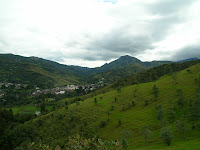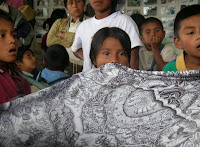 Aunque el tiempo en Popayán y sus alrededores fue muy corto, como en general lo ha sido este primer vuelo por el sur occidente, tuvimos la oportunidad de compartir espacios con niños, niñas y jóvenes de ambientes bien distintos.
Aunque el tiempo en Popayán y sus alrededores fue muy corto, como en general lo ha sido este primer vuelo por el sur occidente, tuvimos la oportunidad de compartir espacios con niños, niñas y jóvenes de ambientes bien distintos.Primero, saliendo de Popayán, en el municipio de Totoró, fuimos a la Granja-Escuela Amalaka, una propuesta distinta a la educación tradicional. Amalaka nació en el año 1991 como un centro educativo de educación no formal, y en agosto de 1996 nació el proyecto de educación formal. Han tenido dos ejes de trabajo que son la relación entre comunicación y estética por un lado, y la educación ambiental por otro, en los que se lleva un proceso muy ligado a las vivencias culturales de la comunidad educativa. En Amalaka los niños y niñas se capacitan desde pequeños en talleres de danza y música, artes y diagramación, panadería y cocina, cerámica, y saberes agropecuarios como cultivos de pancoger, ganado vacuno, ovino, cría de conejos, piscicultura y apicultura. Esta propuesta educativa se lleva a cabo en una extensión de 13 hectáreas donde se está desarrollando una granja integral con cultivos (café biológico, caña de azúcar, frutales), animales (vacas, caballos, gallinas, ovejas), bosques (naturales y reforestados), proyectos productivos (huerta escolar, café, panadería, taller de arte y estampados), y tecnologías alternativas (biodigestor, letrina seca, lagunas de oxidación).

Él proyecto está enfocado hacia la educación formal de comunidades desplazadas por la violencia y la juventud en alto riesgo. Aunque en este momento se encuentran viviendo en barrios marginales de la ciudad de Popayán (comunas del Occidente), en su mayoría provienen de diversas zonas del Cauca y del Sur occidente Colombiano. Además de ellos, también asisten desertores escolares, niños urbanos, estudiantes con necesidades educativas especiales, campesinos e indígenas que conforman una población heterogénea cultural y socialmente, lo que enriquece la propuesta académica.
El ambiente y el espacio hacen de Amalaka una increíble propuesta de esperanza que promete algo mejor. Las Abejas pudimos realizar dos talleres con los jóvenes de la Granja-Escuela que contaron con el interés y participación de todos.
 Los alumnos mencionaron que justo el día anterior tuvieron una minga escolar para cumplir con varias labores que tenían pendientes en la granja. Aunque los estudiantes de Amalaka viven una realidad urbana muy difícil, la escuela queda por fuera del mundo del barrio.
Los alumnos mencionaron que justo el día anterior tuvieron una minga escolar para cumplir con varias labores que tenían pendientes en la granja. Aunque los estudiantes de Amalaka viven una realidad urbana muy difícil, la escuela queda por fuera del mundo del barrio.Terminado este taller, nos fuimos volando de un lado a otro de la ciudad para poder compartir en el mismo día un taller con los y las integrantes de la Casa de la Juventud de la Comuna 7 de Popayán. En la galería de mercado de Las Palmas compartimos con jóvenes de la Casa, con integrantes del Movimiento Palenquero del Cauca y con jóvenes campesinos de Inzá, entre otros grupos. Todos y todas aportaron historias distintas durante el cuenta cuentos, entre otras, que los satélites han tomado información sobre el Macizo Colombiano para saber donde están los intereses mineros e hídricos de la región. En este espacio, más que en otros, nos dieron buenas ideas sobre cómo usar la obra para seguir ampliandola en distintos espacios y contextos.

En el proceso de autocrítica que las Abejas siempre hacemos en todos los lugares a los que volamos para volver la obra menos negativa e incorporar más pensamiento en el cuento, los participantes dieron muchas ideas para ayudar a transmitir mejor el mensaje por medio de actividades más divertidas y creativas para niños y niñas. Propusieron hacer un rompecabezas que se resolvería por partes durante varias sesiones y que se iría explicando, parte por parte, en el orden que se van construyendo. También, a más largo plazo, propusieron otro rompecabezas para menores que lo irían coloreando mientras se va hablando de las historias. Finalmente, propusieron pensar con el grupo los logros que ellos como población marginada han tenido durante la historia buscando significarlos. Algunos logros mencionados fueron las luchas de liberación de la esclavitud por parte de los pueblos indígenas y afrodescendientes.
 Por otro lado, en el encuentro también se mencionaron las maneras cómo el conflicto se vive en las comunas, especialmente, en la juventud. También se habló de la pobreza, las drogas, la prostitución juvenil, las pandillas y los paramilitares. Es común que varias noches a la semana los paramilitares hagan sus rondas de “limpieza social” por las calles de los barrios matando incluso a balazos, entre las paredes de las casas, a jóvenes que vuelven de trabajar o estudiar. Historia fuerte pero es su realidad. Y en medio de esto... siguen los proyectos como las Casas de la Juventud en distintos barrios y aunque no parece mucho, son espacios de creatividad, de exploración y de empoderamiento para la juventud de estos barrios... marginados.
Por otro lado, en el encuentro también se mencionaron las maneras cómo el conflicto se vive en las comunas, especialmente, en la juventud. También se habló de la pobreza, las drogas, la prostitución juvenil, las pandillas y los paramilitares. Es común que varias noches a la semana los paramilitares hagan sus rondas de “limpieza social” por las calles de los barrios matando incluso a balazos, entre las paredes de las casas, a jóvenes que vuelven de trabajar o estudiar. Historia fuerte pero es su realidad. Y en medio de esto... siguen los proyectos como las Casas de la Juventud en distintos barrios y aunque no parece mucho, son espacios de creatividad, de exploración y de empoderamiento para la juventud de estos barrios... marginados. Ya saliendo del Cauca, nos tomamos un breve descanso del vuelo en Santander de Quilichao para conocer y compartir las dos obras de Plan Colombia y el ALCA con el grupo de jóvenes del Tejido de Comunicación de la Asociación de Cabildos Indígenas del Norte del Cauca - ACIN - CXAB WALA KIWE. Fue un tiempo corto pero activo en participación e intercambio y muy bonito porque las Abejas pudimos intercambiar con los pájaros carpinteros del Tejido. La idea es volver para seguir compartiendo nuestro trabajo y también nuestro proceso de crear obras pedagógicas, pero también aprender de la experiencias de los y las carpinteros en creando uno de los mas fuertes redes de comunicación con las comunidades indígenas de la región.
Ya saliendo del Cauca, nos tomamos un breve descanso del vuelo en Santander de Quilichao para conocer y compartir las dos obras de Plan Colombia y el ALCA con el grupo de jóvenes del Tejido de Comunicación de la Asociación de Cabildos Indígenas del Norte del Cauca - ACIN - CXAB WALA KIWE. Fue un tiempo corto pero activo en participación e intercambio y muy bonito porque las Abejas pudimos intercambiar con los pájaros carpinteros del Tejido. La idea es volver para seguir compartiendo nuestro trabajo y también nuestro proceso de crear obras pedagógicas, pero también aprender de la experiencias de los y las carpinteros en creando uno de los mas fuertes redes de comunicación con las comunidades indígenas de la región.-----------------------------------------------------------------------------------------------------------------
First, leaving Popayán, in the municipality of Totoró, we went to the Farm-School Amalaka, a educational approach much different from traditional schooling. Amalaka was born in 1991 as a informal educational center though in august of 1996 it moved towards more formal education. There are two focuses of work, the relationship of communication with aesthetics and environmental education that is incorporated into a process in line with the cultural practices of community education. In Amalaka the children learn from an early age about dance and music, arts and design, baking and cooking, ceramics and agricultural practices such as cash crops and raising cattle, sheep, rabbits, fish and honey bees. This educational approach takes place on an extension of 13 hectares with a crop sustained farm (natural coffee, sugar cane and fruit), animals (cattles, horses, chickens and sheep), forests (natural and reforested), productive projects (school garden, coffee, bakery, art and silk-screening workshop and alternative technologies (biodigesters, dry latrines and oxidation ponds).
Finishing the second story telling we flew from one side of the city to the other to share the story telling the same day with the youth of the Casa de la Juventud (House of the Youth) of the Comuna 7 of Popayán. In the market gallery of Las Palmas we shared with youth from the House, members of the Palenquero Movement of Cauca and with campesino youth from Inzá, Cauca among other groups. All shared different stories during the Plan Colombia story telling, one of those was about the use of satellites to record information from the Macizo Colombiano to know where the mineral and hydrological interests in the region are. In this space more than others we were given fresh ideas on how to apply the use of the graphic in a wider context of pedagogical approaches for differents spaces and environments.























































